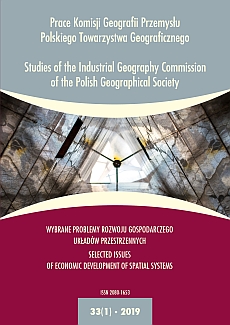Dynamic Multidimensional Scaling of Employment Structure Changes in EU Countries in 1999–2016
DOI:
https://doi.org/10.24917/20801653.331.1Keywords:
employment, European Union, multidimensional scaling, structuresAbstract
Multidimensional Scaling method makes it possible to show the configuration of multivariate objects in the space with less dimensions than the original one (usually on the plane) in such a way that a distance matrix calculated in lower dimension is the most similar to the distance matrix calculated in the original multivariate space. The application of this approach for the analysis of spatio-temporal structures is presented in the paper. Structures are described by shares, so no standardisation (or normalisation) is needed to eliminate the measurement units. Separate Multidimensional Scaling is performed for each time point. On the sequence of results we can follow the changes of object position. Those trajectories can be approximated by trend functions. The example considered in the paper deals with the employment structure in 28 European Union countries in 1999-2016. Structures are calculated on the basis of 10 aggregated sections of the economy.
Downloads
Metrics
References
Borg, I., Groenen, P.J.F. (2005). Modern Multidimensional Scaling. Theory and Applications. Berlin, Heidelberg: Springer.
Borg, I., Groenen, P.J.F., Mair, P. (2013). Applied Multidimensional Scaling. Berlin, Heidelberg: Springer.
Chomątowski, S., Sokołowski, A. (1978). Taksonomia struktur. Przegląd Statystyczny, 2, 217–226.
Council Regulation (EEC) No 3037/90 of 9 October 1990 on the statistical classification of economic activities in the European Community.
Cox, T.F., Cox, M.A.A. (1994). Multidimensional Scaling. London: Chapman & Hall.
Davison, M.L. (1983a). Introduction to Multidimensional Scaling and its Applications. Applied Psychological Measurement, 7, 373–379.
Davison, M.L. (1983b). Multidimensional Scaling. New York: Willey.
Kruskal, J.B. (1964). Multidimensional Scaling and by Optimizing Goodness of Fit to a Nonmetric Hypothesis. Psychometrica, 29(1), 1–27.
Kruskal, J.B., Wish, M. (1978). Multidimensional Scaling. Beverly Hills: Sage.
Markowska, M. (2012). Dynamiczna taksonomia innowacyjności regionów. Wrocław: Wydawnictwo Uniwersytetu Ekonomicznego we Wrocławiu.
Rozporządzenie (WE) nr 1893/2006 Parlamentu Europejskiego i Rady z dnia 20 grudnia 2006 r. w sprawie statystycznej klasyfikacji działalności gospodarczej NACE Rev. 2 i zmieniające rozporządzenie Rady (EWG) nr 3037/90 oraz niektóre rozporządzenia WE w sprawie określonych dziedzin statystycznych (Dz. Urz. UE L/393/1).
Schiffman, S., Reynolds, M.L., Young, F.W. (1981). Introduction to Multidimensional Scaling.Theory, Methods and Applications. Orlando: Academic Press.
Downloads
Published
How to Cite
Issue
Section
License
Articles are published under the terms of the Creative Commons License (CC BY-ND 4.0; Attribution– NoDerivs).

